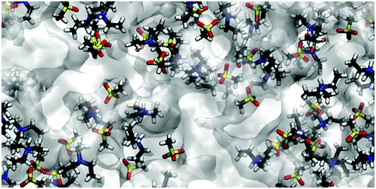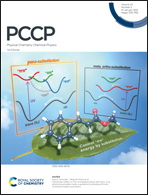The transition from salt-in-water to water-in-salt nanostructures in water solutions of organic ionic liquids relevant for biological applications†
Abstract
The nanostructure in water solutions of three organic ionic liquids relevant for biological applications has been studied by molecular dynamics simulations based on empirical force fields. The three compounds consisted of two different triethylammonium salts, known to affect the fibrillation kinetics of Aβ peptides, and a phosphonium dication, which has been shown to possess a marked bactericidal activity. The structure of solutions spanning a wide concentration range (from 25 to 75 wt%) has been analysed by computing several combinations of partial structure factors, measuring the fluctuation of the ion and water distribution in space. At moderate salt concentration, the results reflect the formation in water of salt-rich domains of nanometric size. With salt concentration increasing beyond 50 wt%, the system enters the so-called water-in-salt regime, in which the aggregation properties of water become relevant, giving origin to water-rich domains in the nearly uniform salt environment. The persistence over a wide concentration range of nearly integer (∼6; ∼4) water–ion coordination numbers suggests the formation of stoichiometric liquid ionic hydrates.



 Please wait while we load your content...
Please wait while we load your content...